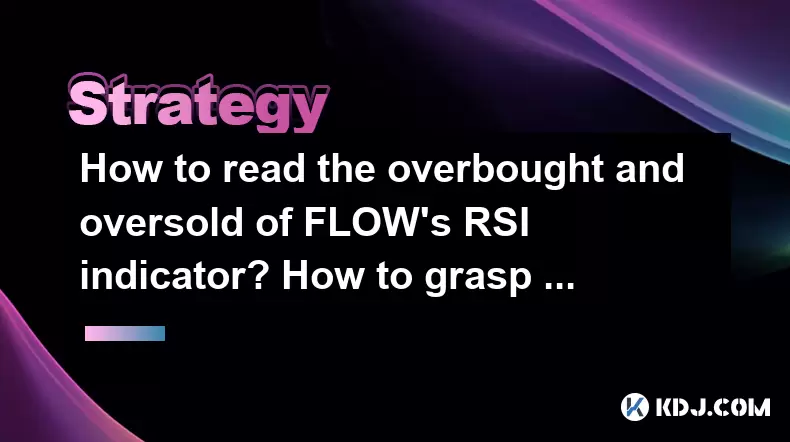-
 bitcoin
bitcoin $124586.364639 USD
0.62% -
 ethereum
ethereum $4670.671710 USD
3.33% -
 xrp
xrp $2.983701 USD
0.18% -
 tether
tether $1.000175 USD
-0.03% -
 bnb
bnb $1209.430642 USD
2.76% -
 solana
solana $231.365861 USD
0.51% -
 usd-coin
usd-coin $0.999665 USD
-0.02% -
 dogecoin
dogecoin $0.264657 USD
4.46% -
 tron
tron $0.346415 USD
1.60% -
 cardano
cardano $0.871586 USD
3.70% -
 chainlink
chainlink $23.451270 USD
7.56% -
 hyperliquid
hyperliquid $46.860071 USD
-2.96% -
 ethena-usde
ethena-usde $1.000120 USD
0.04% -
 sui
sui $3.611279 USD
1.08% -
 stellar
stellar $0.407149 USD
0.96%
How to read the overbought and oversold of FLOW's RSI indicator? How to grasp the buying and selling opportunities?
Use FLOW's RSI to spot buying chances when it's below 30 and selling when above 70, but always confirm with other indicators to avoid false signals.
May 07, 2025 at 06:57 pm

The RSI (Relative Strength Index) is a momentum oscillator that measures the speed and change of price movements. It is widely used in the cryptocurrency market, including for tokens like FLOW, to identify overbought and oversold conditions. Understanding how to read the RSI for FLOW and how to use this information to grasp buying and selling opportunities can be crucial for traders. This article will guide you through the process step-by-step.
Understanding the RSI Indicator
The RSI is typically displayed as a line graph that oscillates between 0 and 100. The RSI is calculated based on the average gain and loss of an asset over a specific period, usually 14 days. The formula for RSI is as follows:
[ \text{RSI} = 100 - \left( \frac{100}{1 + \text{RS}} \right) ]
Where RS (Relative Strength) is the average gain divided by the average loss.
Identifying Overbought and Oversold Levels
An asset is considered overbought when the RSI value exceeds 70, indicating that it may be overvalued and due for a price correction. Conversely, an asset is considered oversold when the RSI value falls below 30, suggesting that it may be undervalued and poised for a price rebound. For FLOW, these levels can help traders identify potential entry and exit points.
Reading FLOW's RSI Indicator
To read FLOW's RSI indicator effectively, follow these steps:
- Access a reliable trading platform or charting tool that supports FLOW and provides RSI indicators.
- Locate the RSI line on the chart. It is usually displayed below the price chart.
- Observe the RSI value to determine if FLOW is in an overbought or oversold state.
For example, if FLOW's RSI is at 75, it indicates that the token is currently overbought. If it's at 25, it suggests that FLOW is oversold.
Grasping Buying Opportunities
Identifying buying opportunities with FLOW's RSI involves the following steps:
- Monitor the RSI for oversold conditions. When the RSI falls below 30, it may signal a potential buying opportunity.
- Look for divergence. If FLOW's price is making lower lows while the RSI is making higher lows, this bullish divergence could indicate an upcoming price increase.
- Confirm with other indicators. Use other technical indicators, such as moving averages or volume, to confirm the buying signal before making a decision.
For instance, if FLOW's RSI drops to 28 and you notice a bullish divergence, this might be a good time to consider buying.
Grasping Selling Opportunities
Identifying selling opportunities with FLOW's RSI involves the following steps:
- Monitor the RSI for overbought conditions. When the RSI rises above 70, it may signal a potential selling opportunity.
- Look for divergence. If FLOW's price is making higher highs while the RSI is making lower highs, this bearish divergence could indicate an upcoming price decrease.
- Confirm with other indicators. Use other technical indicators, such as moving averages or volume, to confirm the selling signal before making a decision.
For instance, if FLOW's RSI rises to 72 and you notice a bearish divergence, this might be a good time to consider selling.
Practical Example: Reading FLOW's RSI
Let's walk through a practical example of reading FLOW's RSI and making trading decisions based on it:
- Scenario: You are monitoring FLOW's RSI on a daily chart.
- Observation: You notice that FLOW's RSI has dropped to 27, indicating an oversold condition.
- Action: You look for bullish divergence and see that while FLOW's price has been making lower lows, the RSI has been making higher lows.
- Confirmation: You check other indicators, such as the 50-day moving average, and see that FLOW's price is approaching this level, suggesting potential support.
- Decision: Based on the oversold RSI, bullish divergence, and support from the moving average, you decide to buy FLOW.
Using RSI in Conjunction with Other Indicators
While the RSI is a powerful tool, it is most effective when used in conjunction with other technical indicators. Here are some ways to combine RSI with other indicators for FLOW:
- Moving Averages: Use moving averages to identify trend direction and potential support and resistance levels. For example, if FLOW's RSI is oversold and the price is approaching the 50-day moving average, this could reinforce a buying decision.
- MACD (Moving Average Convergence Divergence): The MACD can help confirm RSI signals. If the RSI indicates an oversold condition and the MACD shows a bullish crossover, this could strengthen the case for buying FLOW.
- Volume: High volume can confirm the strength of a price move. If FLOW's RSI is oversold and there is a spike in volume as the price begins to rise, this could indicate strong buying pressure.
Limitations of RSI
While the RSI is a useful tool, it has its limitations. False signals can occur, especially in strong trending markets where the RSI may remain overbought or oversold for extended periods. It is important to use the RSI in conjunction with other indicators and to consider the broader market context when making trading decisions.
Practical Tips for Using RSI with FLOW
Here are some practical tips for using the RSI effectively with FLOW:
- Use multiple timeframes. Look at the RSI on different timeframes (e.g., daily, hourly) to get a more comprehensive view of FLOW's momentum.
- Set alerts. Many trading platforms allow you to set alerts for when the RSI reaches certain levels. This can help you stay on top of potential trading opportunities without constantly monitoring the charts.
- Backtest your strategy. Use historical data to backtest your RSI-based trading strategy for FLOW to see how it would have performed in the past.
Frequently Asked Questions
Q: Can the RSI be used as the sole indicator for trading FLOW?A: While the RSI is a valuable tool, it is generally not recommended to use it as the sole indicator for trading FLOW. Combining the RSI with other technical indicators can provide a more robust trading strategy and help confirm signals.
Q: How often should I check FLOW's RSI?A: The frequency of checking FLOW's RSI depends on your trading style. Day traders may check it multiple times a day, while swing traders might check it daily or weekly. Setting alerts for specific RSI levels can help manage this more efficiently.
Q: Is there a specific RSI setting that works best for FLOW?A: The standard setting for the RSI is 14 periods, which works well for most assets, including FLOW. However, some traders may experiment with different settings, such as 9 or 25 periods, to see if they provide better signals for their trading strategy.
Q: Can the RSI be used to predict long-term trends for FLOW?A: The RSI is primarily a short-term momentum indicator and is not typically used to predict long-term trends. For long-term trend analysis, other indicators such as moving averages or trend lines may be more suitable.
Disclaimer:info@kdj.com
The information provided is not trading advice. kdj.com does not assume any responsibility for any investments made based on the information provided in this article. Cryptocurrencies are highly volatile and it is highly recommended that you invest with caution after thorough research!
If you believe that the content used on this website infringes your copyright, please contact us immediately (info@kdj.com) and we will delete it promptly.
- BlockDAG, DOGE, HYPE Sponsorship: Crypto Trends Shaping 2025
- 2025-10-01 00:25:13
- Deutsche Börse and Circle: A StableCoin Adoption Powerhouse in Europe
- 2025-10-01 00:25:13
- BlockDAG's Presale Buzz: Is It the Crypto to Watch in October 2025?
- 2025-10-01 00:30:13
- Bitcoin, Crypto, and IQ: When Genius Meets Digital Gold?
- 2025-10-01 00:30:13
- Stablecoins, American Innovation, and Wallet Tokens: The Next Frontier
- 2025-10-01 00:35:12
- NBU, Coins, and Crypto in Ukraine: A New Yorker's Take
- 2025-10-01 00:45:14
Related knowledge

Practical parameter settings for a Bitcoin multi-timeframe moving average system
Sep 18,2025 at 10:54pm
Optimizing Timeframe Combinations for Bitcoin Trading1. Selecting appropriate timeframes is crucial when building a multi-timeframe moving average sys...

How can I filter out false breakouts in Dogecoin high-frequency trading?
Sep 22,2025 at 01:00am
Understanding False Breakouts in Dogecoin Trading1. A false breakout occurs when Dogecoin's price appears to move beyond a defined support or resistan...

Techniques for identifying tops and bottoms in the Bitcoin on-chain NVT model
Sep 20,2025 at 07:54pm
Understanding the NVT Model in Bitcoin Analysis1. The Network Value to Transactions (NVT) ratio is often described as the 'P/E ratio' of the cryptocur...

What does the surge in open interest in Bitcoincoin futures mean?
Sep 20,2025 at 11:18pm
Understanding the Surge in Dogecoin Futures Open Interest1. A surge in open interest within Dogecoin futures indicates a growing number of active cont...

How can I use the Ethereum USDT premium to gauge market sentiment?
Sep 18,2025 at 11:55pm
Understanding the Ethereum USDT Premium1. The Ethereum USDT premium refers to the price difference between USDT (Tether) traded on Ethereum-based plat...

What should I do if Ethereum staking yields decline?
Sep 20,2025 at 06:18am
Understanding the Causes Behind Declining Ethereum Staking Yields1. The Ethereum network transitioned to a proof-of-stake consensus mechanism with the...

Practical parameter settings for a Bitcoin multi-timeframe moving average system
Sep 18,2025 at 10:54pm
Optimizing Timeframe Combinations for Bitcoin Trading1. Selecting appropriate timeframes is crucial when building a multi-timeframe moving average sys...

How can I filter out false breakouts in Dogecoin high-frequency trading?
Sep 22,2025 at 01:00am
Understanding False Breakouts in Dogecoin Trading1. A false breakout occurs when Dogecoin's price appears to move beyond a defined support or resistan...

Techniques for identifying tops and bottoms in the Bitcoin on-chain NVT model
Sep 20,2025 at 07:54pm
Understanding the NVT Model in Bitcoin Analysis1. The Network Value to Transactions (NVT) ratio is often described as the 'P/E ratio' of the cryptocur...

What does the surge in open interest in Bitcoincoin futures mean?
Sep 20,2025 at 11:18pm
Understanding the Surge in Dogecoin Futures Open Interest1. A surge in open interest within Dogecoin futures indicates a growing number of active cont...

How can I use the Ethereum USDT premium to gauge market sentiment?
Sep 18,2025 at 11:55pm
Understanding the Ethereum USDT Premium1. The Ethereum USDT premium refers to the price difference between USDT (Tether) traded on Ethereum-based plat...

What should I do if Ethereum staking yields decline?
Sep 20,2025 at 06:18am
Understanding the Causes Behind Declining Ethereum Staking Yields1. The Ethereum network transitioned to a proof-of-stake consensus mechanism with the...
See all articles










































































